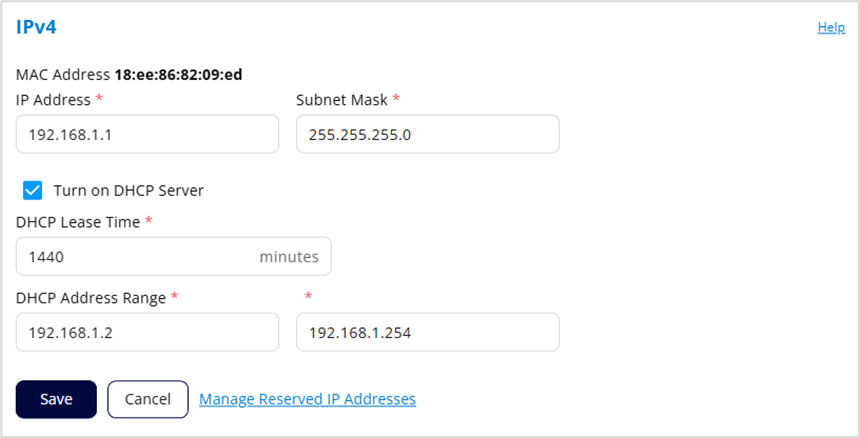User Guide
- Product documentation
- Inseego Wavemaker™ FX4100
- English
- User Guide
IPv4
Use this section if you need to make changes to your router’s IPv4 address or subnet mask, or if you want to adjust DHCP server settings.

MAC Address: The Media Access Controller (MAC) Address for the Wi-Fi interface on your router (read-only). The MAC address is a unique network identifier assigned when a network device is manufactured.
IP Address: The IP address for your router, as seen from the local network. Normally, you can use the default value*.
Subnet Mask: The subnet mask network setting for the router. The default value 255.255.255.0 is standard for small (class "C") networks. If you change the LAN IP address above, make sure to use the correct subnet mask for the IP address range of the LAN IP address*.
Turn on DHCP server: The DHCP server is on by default. The DHCP server allocates an IP address to each connected device.
NOTE: If the DHCP Server is turned off, each connected device must be assigned a fixed IP address.
DHCP Address Range: The start and end of the IP address range used by the DHCP server. If the IP address is set on the client device, use an IP address outside of this DHCP range; if the IP address is set using an IP reservation, it will usually be inside this range.
NOTE: Only expert users should change this setting.
DHCP Lease Time: The number of minutes in which connected devices must renew the IP address assigned to them by the DHCP server. Normally, this can be left at the default value, but if you have special requirements, you can change it.
Manage Reserved IP Addresses: Use this button to set up reserved IP addresses. Reserved IP addresses ensure that a connected device will always be allocated the same IP address.

Connected devices display automatically. To manually add a device:
- Click the Add button to start a new row.
- Enter a name, MAC address and a reserved IP address that falls between the values set in DHCP Address Range.
- Check the Reserve checkbox if you want to reserve the address.
- Click Save.
Click Save to activate and save IPv4 settings.
| * If you are using a 255.0.0.0 (class “A”), or 255.255.0.0 (class “B”) network, the 3rd octet of the IP address must be an even number (for example: x.x.2.x/10.5.2.1). |
